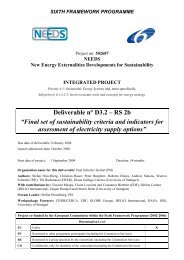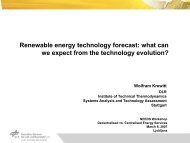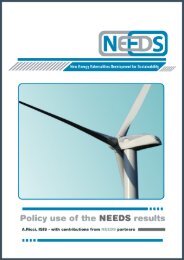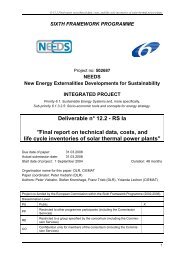Generation, of the energy carrier HYDROGEN In context ... - needs
Generation, of the energy carrier HYDROGEN In context ... - needs
Generation, of the energy carrier HYDROGEN In context ... - needs
Create successful ePaper yourself
Turn your PDF publications into a flip-book with our unique Google optimized e-Paper software.
NyOrka Page 23 12/18/20084.2 Criteria for hydrogen applicationsThe production pathway selected for fur<strong>the</strong>r analysis emphasises <strong>the</strong> electrolytichydrogen production in as competitive and secure operation as possible and <strong>the</strong>nadjusting <strong>the</strong>se to optimal efficiency. The current bulk production method; steamreformation from gas will also be used as reference.4.2.1 Efficency <strong>of</strong> productionCurrent electrolysers show an efficiency <strong>of</strong> about 65 - 75% but <strong>the</strong> goal is to raise it up to87% by 2020. <strong>In</strong> future models <strong>the</strong> technology may allow for electrolysis to be carriedout under high pressure and partial substitution (up to 20%) <strong>of</strong> <strong>the</strong> electric <strong>energy</strong> withhigh heat. As a rule <strong>the</strong> efficiency <strong>of</strong> low pressure electrolysers is given with <strong>the</strong>following function:ηsystem=m * H 2HH 2EElectrwhere m H2 : Mass <strong>of</strong> produced hydrogenH H2 : Heat value <strong>of</strong> hydrogenE Electr : Amount <strong>of</strong> electricity 24If <strong>the</strong> pressure in <strong>the</strong> electrolyser is raised this is done only to reduce <strong>the</strong> volume <strong>of</strong>hydrogen and <strong>the</strong>refore <strong>the</strong> space <strong>of</strong> hydrogen stations. When high heat is added to <strong>the</strong>process <strong>the</strong> voltage can be lowered from 1,48Volt to 1,23Volt.4.2.2 Quality criteriaModern PEM fuel cells are sensitive to impurities carried in hydrogen. The purity issometimes simplified to four, five or six nines (99,99%; 99,999% and 99,9999%), but <strong>the</strong>tolerance is not equal for all impurities. Within <strong>the</strong> HyFLEET:CUTE project, <strong>the</strong> brakedown <strong>of</strong> cost components <strong>of</strong> hydrogen revealed that monitoring and analysing <strong>the</strong> qualityas well as purification <strong>of</strong> hydrogen has significant impact on its price. The PEM fuel cellsare mostly applied in vehicles but for stationary applications o<strong>the</strong>r types are more costeffective and <strong>the</strong>y can use a range <strong>of</strong> fuel types. The proportional in-stallation <strong>of</strong> fuel celltypes is presented in <strong>the</strong> fuel cell chapter.From electrolytic hydrogen <strong>the</strong> impurities consist mainly <strong>of</strong> O 2 that damages <strong>the</strong> coatings<strong>of</strong> PEM fuel cells. Impurities from gas-reformation can be H 2 O, CO, CO 2 or N-compounds and those can harm PEM fuel cells but types <strong>of</strong> stationary FCs can withstandmore impurity (see section on fuel cells). <strong>In</strong>ternational standards for purity have not beenset but are ra<strong>the</strong>r negotiated along <strong>the</strong> delivery chain. Drying and purification can raiseprices and can become <strong>energy</strong> intensive within <strong>the</strong> reformation or gasification methods(see section on hydrogen costs). Whereas <strong>the</strong> NEEDS project is dedicated to hydrogen in24 Faltenbacher Michael, PE <strong>In</strong>ternational 2006, report on LCA <strong>of</strong> hydrogen production within CUTE cities







